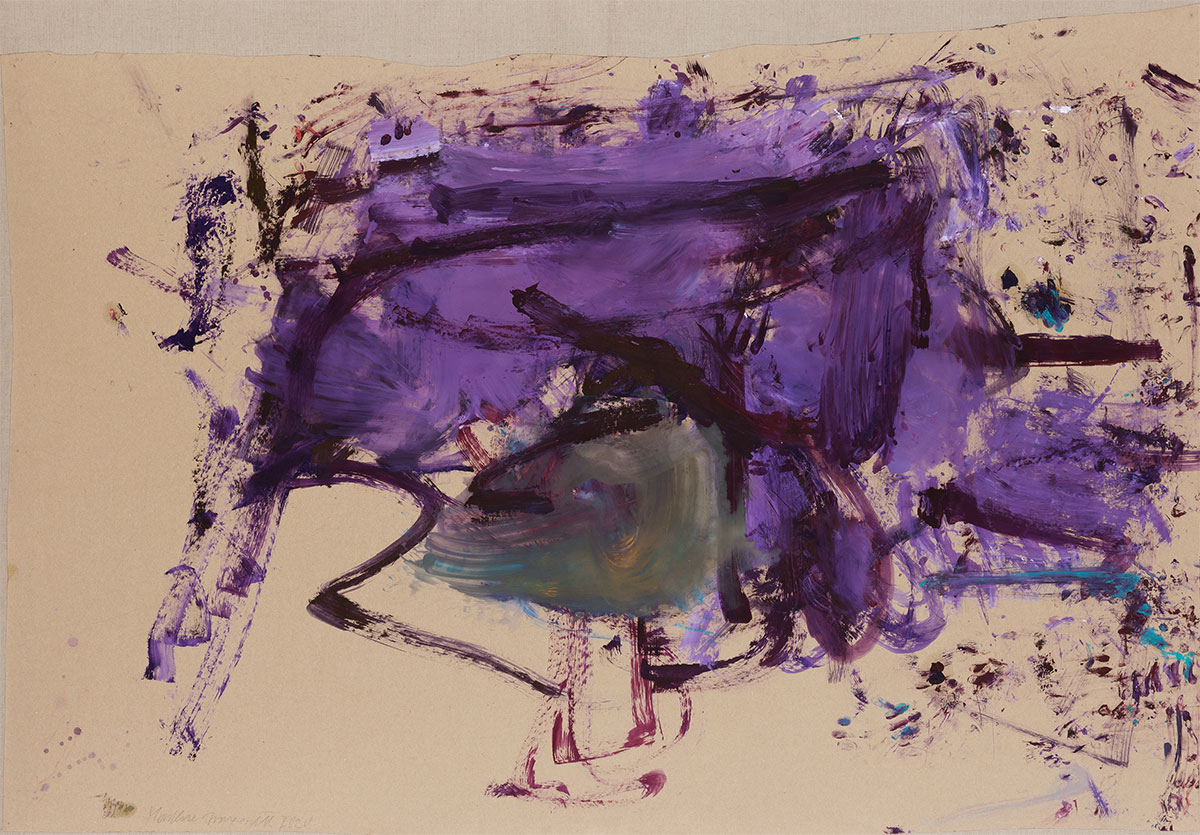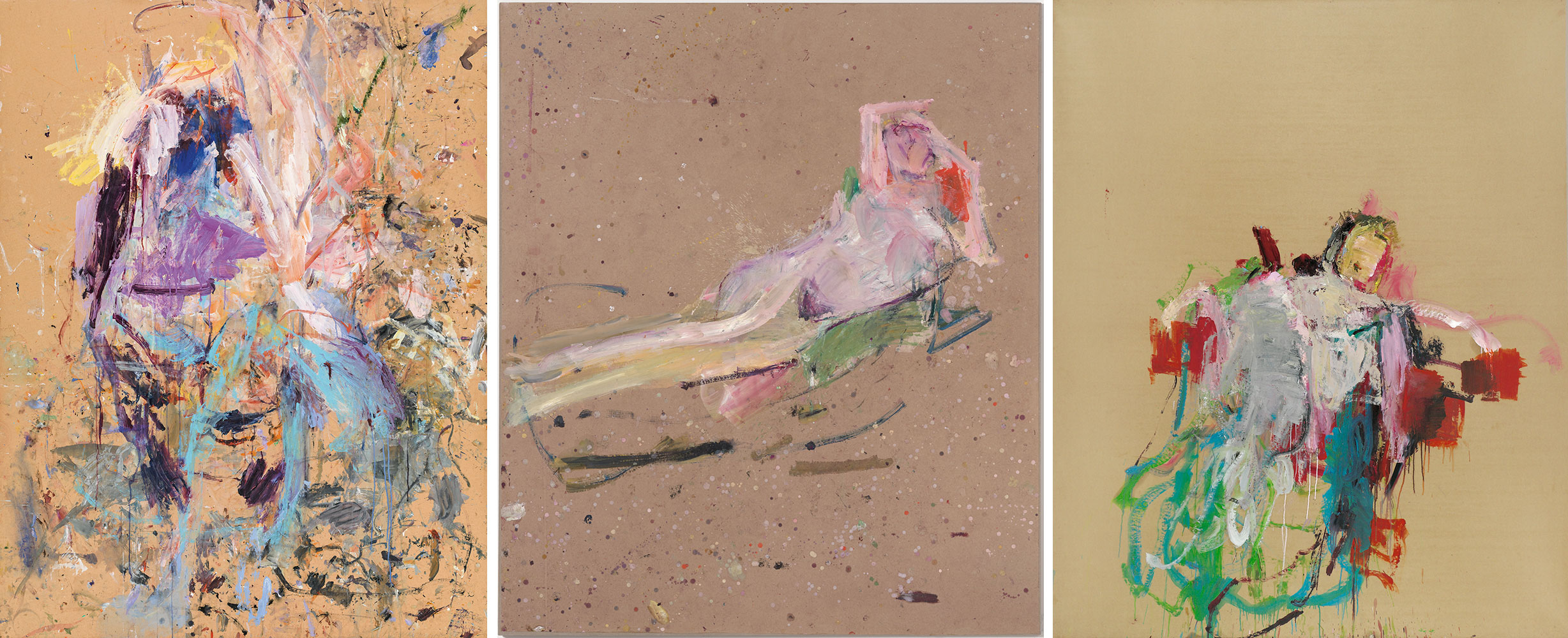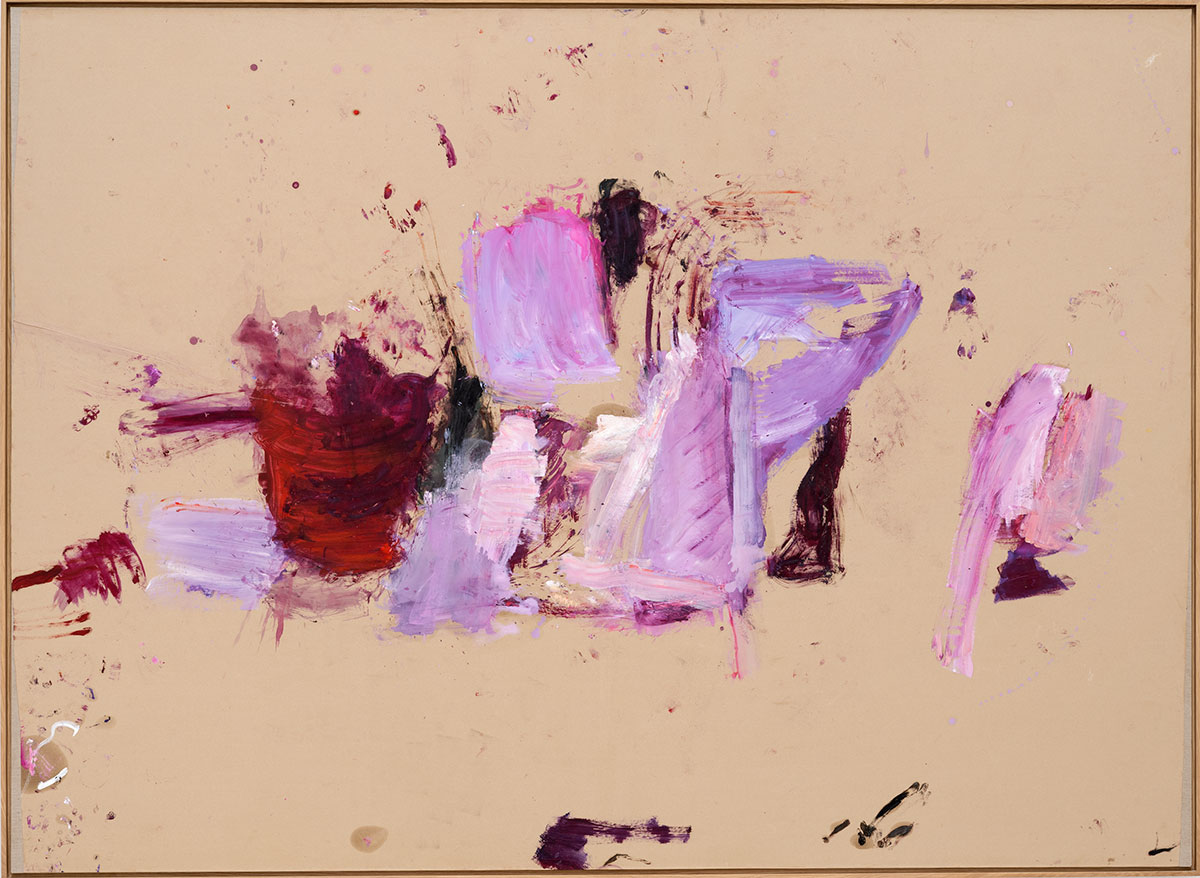PRESENTATION: Martha Jungwirth
 Martha Jungwirth has forged a singular approach to abstraction that is grounded in the body and closely observed perceptions of the world around her. With an idiosyncratic, non-conformist approach to painting, her works occupy an intuitive space that exists beyond the formation of recognisable images, ‘before spoken language’, ‘before memory’ and ‘before the obtrusiveness of objects’. The compositions reveal themselves to her during the painting process, which she describes as an ‘adventure’, creating in concert with her materials to produce works that are poised between chance and calculation.
Martha Jungwirth has forged a singular approach to abstraction that is grounded in the body and closely observed perceptions of the world around her. With an idiosyncratic, non-conformist approach to painting, her works occupy an intuitive space that exists beyond the formation of recognisable images, ‘before spoken language’, ‘before memory’ and ‘before the obtrusiveness of objects’. The compositions reveal themselves to her during the painting process, which she describes as an ‘adventure’, creating in concert with her materials to produce works that are poised between chance and calculation.
By Efi Michalarou
Photo: Guggenheim Museum Bilbao Archive
Martha Jungwirth’s retrospective exhibition at Guggenheim Museum Bilbao features seventy works that encompass six decades of work. Ranging from 1976 to 2023, the works in the show include a substantial selection of watercolors and oil paintings as well as three artist books spanning nearly 50 years of remarkable production. Jungwirth’s paintings and watercolors are informed by close observation of the human form, animals, the history of art, and extensive travel around the world. The resulting artworks evoke a sense of spontaneity through their erratic forms and intense colors. Martha Jungwirth’s artwork will be shown in Spain for the first time since 1966, when she was awarded the Joan Miró Prize. Martha Jungwirth stands as a seminal figure in the Austrian art scene. Rooted in the cultural and artistic milieu of postwar Vienna, she studied art at the Universität für Angewandte Kunst (University of Applied Arts), Vienna, from 1956 to 1963. Despite the shifting trends within painting, Jungwirth consistently dedicated herself to developing a unique abstract style that draws on myriad influences from her life. Her early work demonstrates a distinct approach for the visceral and the subjective characterized by a fusion of Abstract Expressionism and a raw, emotive quality, setting the stage for the development of her unique aesthetic. Over the years, Jungwirth has exhibited a remarkable ability to evolve and adapt her artistic language. Her subject matter is as diverse as her own interests, ranging from introspective self-portraits to landscapes and works inspired by current events, such as COVID-19 or the Australian bushfires. Jungwirth’s paintings and drawings masterfully navigate the delicate boundary between realism and abstraction. Her artworks don’t aim to depict a straightforward narrative or visual representation, rather they are defined by their explosive, gestural strokes and vibrant hues that serve as poignant expressions. Through colors that carry emotional weight and gestural forms that hint at their origins, Jungwirth’s paintings defy easy categorization. Her work captures not just fleeting moments or mere images, but encapsulates profound experiences, emotions, and memories, and through her art, Jungwirth imparts an insightful understanding of the boundless intricacies of reality, offering viewers a glimpse into the depths of human perception and consciousness. Jungwirth’s energetic paintings are decidedly non-conformist in style and are made on unexpected supports, such as cardboard, accounting books, or brown paper. The artist has consistently sought liberation in her engagement with unusual materials that defy the conventions of traditional artistic repertoires reveling in the non-precious, the overlooked, and the unorthodox. These weathered relics, marked by tattered edges and stains, serve as both her canvas and a catalyst for uninhibited expression, inviting her to navigate the nuanced contours of control and chaos with a spirited freedom that transcends conventional artistic boundaries. Jungwirth’s work extends beyond the mere selection of uncommon materials; it transforms them into a dialogue with ordered systems within the physical realm. The juxtaposition of materials designed to impose order becomes, in Jungwirth’s hands, a fertile ground for gestural, spontaneous, and brilliantly colored brushwork.
Exhibition overview: Objects and People: The exhibition opens with Jungwirth’s earliest works, a selection of large-scale drawings of ordinary objects from her “Indesit” series which marks the genesis of her artistic career as it might be understood fifty years later, representing the beginning of her nuanced navigations between realism and abstraction. Also on display in this section is a selection of portraits and groups of people that are representative of the artist’s shift to working exclusively with watercolors and oils. However unexpected for an abstract artist, the genre of portraiture is one the artist has revisited over the years, melding the human form with expressive, gestural brushwork and color. Defying the confines of traditional portraiture, Jungwirth’s engagement with the genre displays an innate ability to capture the inner essence and character of her sitters rather than a literal representation. Painting Escapes: In addition to her focus on the internal landscape, Jungwirth has consistently turned her gaze outward, exploring the natural world. Travel as a form of artistic research has been fundamental to her practice since the 1970s. Jungwirth’s travels have always been immersive experiences fueled by reading classical literature, studying architectural history, and other parallel pursuits which serve to imbue her paintings with the rich cultural textures acquired during her journeys. The paintings that result from her trips are not mere representations of the places she has visited but rather emotional responses to the moods and sensations invoked by nature. Through a synthesis of abstraction and recognizable forms, Jungwirth creates a dialogue between the internal and external, inviting viewers to experience the profound connection between the self and the world. Animals as Imagery: In Jungwirth’s recent animal paintings, the convergence of history and current events is palpable through a selection of paintings that have their roots in the stark reality of the world grappling with climate change. Her recent “Australidelphia” series (2020) focuses on Australian marsupial mammals, some of which are termed “living fossils” due to their unchanged characteristics from prehistoric times. The series is not just a nod to these ancient creatures but also a reflection on the devastating bushfires that ravaged Australia in 2019–20, leading to immense animal casualties. While the paintings resist simplistic reductions to recognizable images, the chromatic elements—comprising pink, red, brown, and black motifs—within her compositions symbolize the external violence these species faced. Art History: Jungwirth consistently finds inspiration in a wide spectrum of painters, encompassing both celebrated figures and those less prominently featured in the canon. Her series of paintings inspired by artists like Richard Gerstl, Frans Hals, and Oskar Kokoschka exemplify her expansive exploration of art history. In her latest works, she looks to the masterpieces of Francisco de Goya and Édouard Manet, infusing them with her distinctive artistic vocabulary, resulting in radical departures from the original sources. Amid this convergence of historical narratives and contemporary interpretations, her ongoing experiments with the materiality of paint remain evident striking a balance between gesture and open space, abstraction and realism.
Photo: Martha Jungwirth, Bull (Stier ), 2020, Oil on paper over canvas, 144.5 x 208.5 cm, Private collection, © Martha Jungwirth, Bilbao, 2024, Photo Lisa Rastl
Info: Curator: Lekha Hileman Waitoller, Guggenheim Museum Bilbao, Abandoibarra Etorb., 2, Abando, Bilbo, Bizkaia, Spain, Duration: 7/6-22/9/2024, Days & Hours: Tue-Sun 10:00-20:00, www.guggenheim-bilbao.eus/

Center: Martha Jungwirth, Maja III, from the series Francisco de Goya, Maja (Maja III , aus der Serie Francisco de Goya, Maja ), 2022, Oil on paper over canvas, 264.5 x 226.8 cm, Alkar Contemporary Collection (ACC), Bilbao, © Martha Jungwirth, Bilbao, 2024, Photo Ulrich Ghezzi
Right: Martha Jungwirth, Portrait U. K. (Porträt U. K .), 2019, 235 x 195 cm, Oil on paper over canvas, Sammlung Öesterreichische Nationalbank, © Martha Jungwirth, Bilbao, 2024, Photo OeNB






